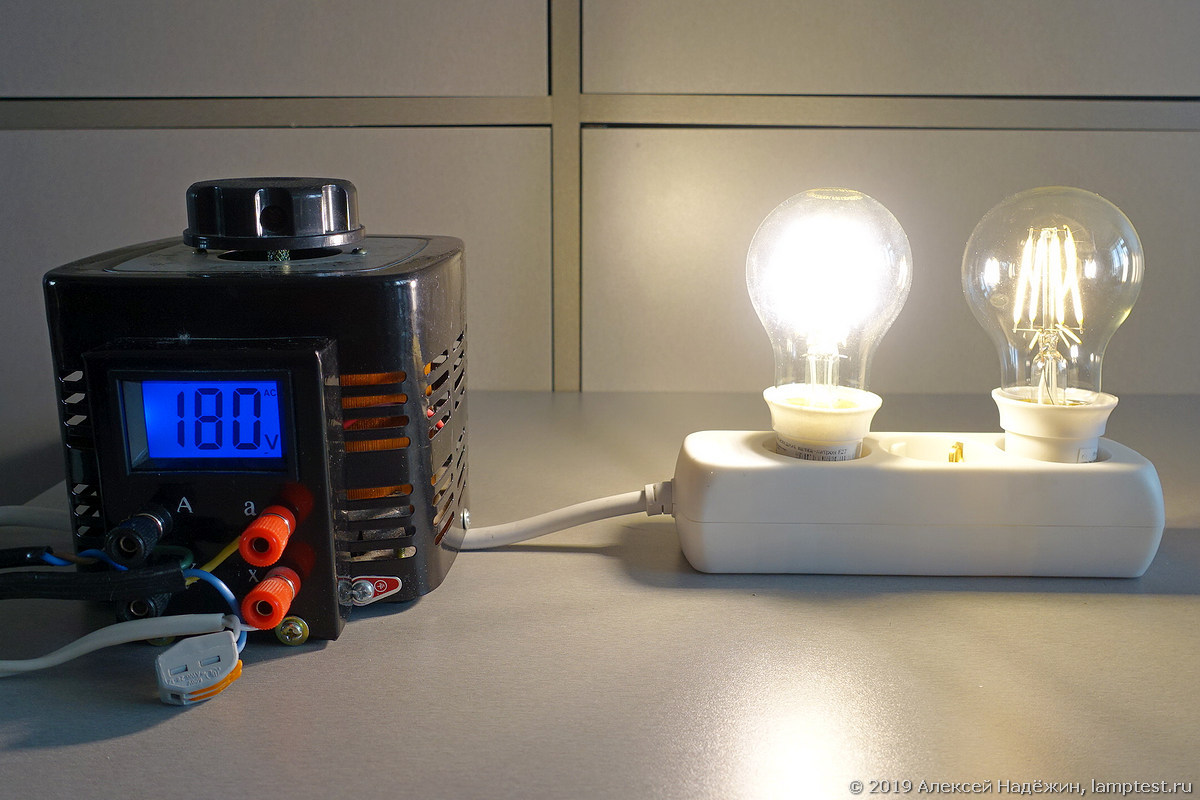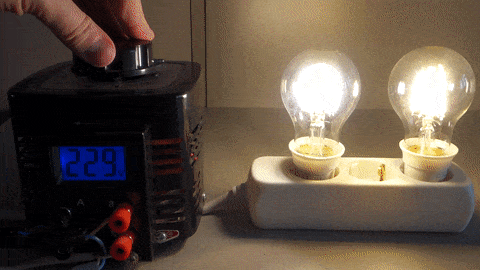A very important parameter of LED lamps, of which very few people know
On the packages of LED lamps you can find many parameters: power, luminous flux, power equivalent, color rendering index. But one very important parameter manufacturers rarely indicate. This is a type of driver.

According to GOST 29322-92 , the network should have a voltage of 230 volts, but the same GOST allows for a deviation of the mains voltage of ± 10%, that is, a voltage from 207 to 253 volts is acceptable. However, in many areas (especially rural), the voltage sometimes drops to 180 volts and below.
Under reduced voltage, ordinary Ilyich bulbs shine much dimmer. At the lower threshold of the allowable voltage of 207 volts, a 60-watt incandescent lamp rated for 230 V shines like a 40-watt one at rated voltage ( habr.com/ru/company/lamptest/blog/386513/ ).
')
The operation of low voltage LED lamps depends on the type of electronic circuit used (driver).
If the lamp uses the simplest RC driver or a linear driver on a microcircuit, the lamp behaves almost the same way as an incandescent lamp (shines dimmer when the voltage drops, and at voltage surges in the network, its light “twitches”).
If an IC driver is used, the brightness of the lamp does not change when the supply voltage changes in a very wide range. In fact, these lamps have a built-in stabilizer.
If you look at all the LED lamps that I tested in the Lamptest.ru project, determining the type of driver, it turns out that 3/4 of all the lamps have an IC driver and only a quarter have a linear or RC driver. If you look only at the filament lamps, the picture changes dramatically: out of 321 lamps tested, only 131 (40%) have IC drivers.
For most lamps with a linear driver, the brightness drops by 5% from the nominal one when the voltage drops to 210-220 V and by 10% at a voltage of 200-210V.
Some lamps with an IC driver do not reduce the brightness when the voltage drops to even 50 volts, but most work stably at voltages from 150 volts.
This is how two filament lamps behave (left with an IC driver, right with a linear one) when the voltage changes from 230 to 160 volts.

I measure the minimum voltage at which the luminous flux of the lamp drops by no more than 5% of the nominal. In the Lamptest results table, this voltage is indicated in the “Vmin” column. If the light flux starts to fall immediately when the voltage drops, I indicate the linear (LIN) driver type (“drv” column), if the light flux is stable when the voltage drops, and then it starts to decrease, the IC1 driver type, if the lamp turns off when the voltage drops, - IC2, if it starts to flash - IC3.
Unfortunately, it is almost impossible to know the type of driver in terms of lamp packaging and the parameters provided by manufacturers on the websites. Some manufacturers write on the package "IC driver". More often they write a wide voltage range, for example, “170-260V”, but this is not always the case. At Lamptest, there are many lamps that have wide voltage ranges indicated, and in fact they have a linear driver installed and on the lower boundary of the specified range they are lit up completely. Specifying a narrow range of "220-240 V" or just "230 V" also does not mean anything: many of these lamps are built on the IC driver and actually work at much lower voltages without dimming.
All I can advise to determine the type of driver is to look at the results of Lamptest on the lamp or its analogs (the same manufacturer, the same type, the same base), if a particular lamp model has not yet been tested.
Of course, lamps with an IC driver are better. They do not change the brightness with decreasing voltage in the network and their light does not “jerk” when the voltage drops. In addition, such a driver is obviously better protected from any voltage drops and is generally more reliable.
I recommend taking into account when choosing a LED lamp driver type and, if possible, buy a lamp with an IC driver.
© 2019, Alexey Nadyozhin

According to GOST 29322-92 , the network should have a voltage of 230 volts, but the same GOST allows for a deviation of the mains voltage of ± 10%, that is, a voltage from 207 to 253 volts is acceptable. However, in many areas (especially rural), the voltage sometimes drops to 180 volts and below.
Under reduced voltage, ordinary Ilyich bulbs shine much dimmer. At the lower threshold of the allowable voltage of 207 volts, a 60-watt incandescent lamp rated for 230 V shines like a 40-watt one at rated voltage ( habr.com/ru/company/lamptest/blog/386513/ ).
')
The operation of low voltage LED lamps depends on the type of electronic circuit used (driver).
If the lamp uses the simplest RC driver or a linear driver on a microcircuit, the lamp behaves almost the same way as an incandescent lamp (shines dimmer when the voltage drops, and at voltage surges in the network, its light “twitches”).
If an IC driver is used, the brightness of the lamp does not change when the supply voltage changes in a very wide range. In fact, these lamps have a built-in stabilizer.
If you look at all the LED lamps that I tested in the Lamptest.ru project, determining the type of driver, it turns out that 3/4 of all the lamps have an IC driver and only a quarter have a linear or RC driver. If you look only at the filament lamps, the picture changes dramatically: out of 321 lamps tested, only 131 (40%) have IC drivers.
For most lamps with a linear driver, the brightness drops by 5% from the nominal one when the voltage drops to 210-220 V and by 10% at a voltage of 200-210V.
Some lamps with an IC driver do not reduce the brightness when the voltage drops to even 50 volts, but most work stably at voltages from 150 volts.
This is how two filament lamps behave (left with an IC driver, right with a linear one) when the voltage changes from 230 to 160 volts.

I measure the minimum voltage at which the luminous flux of the lamp drops by no more than 5% of the nominal. In the Lamptest results table, this voltage is indicated in the “Vmin” column. If the light flux starts to fall immediately when the voltage drops, I indicate the linear (LIN) driver type (“drv” column), if the light flux is stable when the voltage drops, and then it starts to decrease, the IC1 driver type, if the lamp turns off when the voltage drops, - IC2, if it starts to flash - IC3.
Unfortunately, it is almost impossible to know the type of driver in terms of lamp packaging and the parameters provided by manufacturers on the websites. Some manufacturers write on the package "IC driver". More often they write a wide voltage range, for example, “170-260V”, but this is not always the case. At Lamptest, there are many lamps that have wide voltage ranges indicated, and in fact they have a linear driver installed and on the lower boundary of the specified range they are lit up completely. Specifying a narrow range of "220-240 V" or just "230 V" also does not mean anything: many of these lamps are built on the IC driver and actually work at much lower voltages without dimming.
All I can advise to determine the type of driver is to look at the results of Lamptest on the lamp or its analogs (the same manufacturer, the same type, the same base), if a particular lamp model has not yet been tested.
Of course, lamps with an IC driver are better. They do not change the brightness with decreasing voltage in the network and their light does not “jerk” when the voltage drops. In addition, such a driver is obviously better protected from any voltage drops and is generally more reliable.
I recommend taking into account when choosing a LED lamp driver type and, if possible, buy a lamp with an IC driver.
© 2019, Alexey Nadyozhin
Source: https://habr.com/ru/post/447686/
All Articles